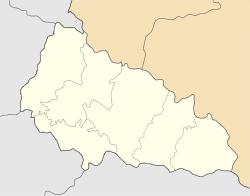Svaliava(Ukrainian:Свалява,Rusyn:Свалява,Hungarian:Szolyva,Slovak:Svaľava,Yiddish:סוואליאוועSvalyave) is acitylocated on theLatorytsia RiverinZakarpattia Oblastin westernUkraine.It was the administrative center of the formerSvaliava Raion(district) until 2020, but now it is inMukachevo Raion.Population:17,068 (2022 estimate).[1]
Svaliava
Свалява | |
|---|---|
City | |
 | |
| Coordinates:48°32′50″N22°59′10″E/ 48.54722°N 22.98611°E | |
| Country | |
| Oblast | Zakarpattia Oblast |
| Raion | Mukachevo Raion |
| Hromada | Svaliava urban hromada |
| Founded | 12th century |
| Incorporated | 1957 |
| Government | |
| •Mayor | Ivan Lanyo |
| Population (2022) | |
| • Total | 17,068 |
| Time zone | UTC+1(CET) |
| • Summer (DST) | UTC+2(CEST) |
| Postal code | 89300 |
| Area code | +380-3133 |
| Climate | Dfb |
| Website | http://www.svalyava.org/ |
Due to the city's complex history, there are also alternative names for it in other languages, including:Czech:Svaljava,German:SchwalbachorSchwallbach,Romanian:Svaliava,Russian:Свалява.
Demographics
editThe2001 censusofficially identified more than 94% of the population.[2]
- Ukrainians94.5%
- Russians1.5%
- Hungarians0.7%
- Slovaks0.6%
History
editSwaljawa was first mentioned in the 12th century as a small settlement of a Hungarian feudal lord. In the 18th century, the village was annexed to the Austro-Hungarian Monarchy and was called Schwalbach. These lands later passed to the Count of Schönborn and his descendants. Gradually, Swaljawa became a multinational town with a significant part of the population being ethnic Germans.[3]
According to the census of 1910, 47.1% of the population was Greek Catholic, 26.2% Jewish and 22.9% Roman Catholic. The Jewish population was deported to Auschwitz after theGerman occupation of Hungary,in May 1944, and most of them was murdered there.
After theSecond World Waraconcentration campwas working near the town. Hungarian and German-born civilians (born between 1896, and 1926) were carried off bySovietforces to the camp purely on the basis of their nationality. They were ordered to report for "malenkij robot"(a corrupted Russian for" small work "), but most of them – more than 20 thousand deportees were killed in the deathcamp after being subjected to various tortures (no water for days, glass powder mixed into their food). A further 50 000, or so Hungarians (not only men, but also women and children) were deported from Szolyva to theSoviet UnionorGalicia.They were later exterminated.[4]The site of the camp is now a memorial park established in 1994.[5]
Gallery
edit-
St. Nicholas Church
-
Synagogue in Svaliava
-
Former synagogue, now a bakery
-
Former synagogue
-
Jewish cemetery
-
Memorial park in Svaliava
References
edit- ^Чисельність наявного населення України на 1 січня 2022[Number of Present Population of Ukraine, as of January 1, 2022](PDF)(in Ukrainian and English). Kyiv:State Statistics Service of Ukraine.Archived(PDF)from the original on 4 July 2022.
- ^"Всеукраїнський перепис населення 2001 | English version | Results | General results of the census | National composition of population | Zakarpattia region".www.ukrcensus.gov.ua.Archived fromthe originalon 11 September 2007.Retrieved12 January2022.
- ^"Deutsche der Ukraine. Wer sind Sie?"(in German). 28 October 2020.Retrieved2023-03-14.
- ^"Magyar holokauszt".3 December 2008.
- ^"The memorial park in Svalyava town - Places of interest from a to Z, Places of interest / Places of interest".Archived fromthe originalon 2016-03-04.Retrieved2014-10-24.



